Classification / Names
आम नाम | उपशब्द | Catalog of Fishes(वर्ग, प्रजाति) | ITIS | CoL | WoRMS | Cloffa
>
Callionymiformes (Dragonets) >
Callionymidae (Dragonets)
Etymology: Protogrammus: Greek, pro = first, in front of + Greek, gramma = letter, signal (Ref. 45335); antipodus: Named after the antipodes, as it occurs very far from its sister species P.sousai of Northeast Atlantic..
More on author: Fricke.
Environment: milieu / climate zone / depth range / distribution range
पारिस्थितिकी
समुद्री ड़िमरसल; गहराई सीमा 70 - 220 m (Ref. 78107). Tropical
Western Pacific: New Caledonia.
आकार / वज़न / Age
Maturity: Lm ? range ? - ? cm
Max length : 2.1 cm SL पुल्लिंग / अलिंग; (Ref. 78107); 2.9 cm SL (female)
Short description
आकृति विज्ञान | मौरफोमैटरिक्स
पृष्ठीय रीढ़ (सम्पूर्ण): 4; पृष्ठीय सौफट रेज़ (सम्पूर्ण): 8-9; ऐनल सौफट रेज़: 1. This species is distinct with the following characters: preopercular spine with 3-7 dorsal points;
anal fin rays 8; 7 relatively long segments in the ventrolateral fold of skin; first dorsal fin in males filamentous 1st to 3rd spines; anal fin with distal black streaks (Ref. 78107).
Dredged on sand bottom with coralline gravel or rubble at depths of 70-220 m, but possibly restricted to 130-210 m (Ref. 78107).
Life cycle and mating behavior
परिपक्व अवधि | पुनरुत्पत्ति | मछलीऔ का अंडे देना | अंडे | Fecundity | लार्वा
Fricke, R., 2006. Two new species and a new record of dragonets from New Caledonia (Teleostei: Callionymidae). Stuttg. Beitr. Naturk. Ser. A (Biol.) 696:1-14. (Ref. 78107)
IUCN Red List Status (Ref. 130435)
Threat to humans
Harmless
Human uses
अधिक जानकारी
आम नामउपशब्दचपायचयपरभक्षीईकोटोकसीकोलौजीपुनरुत्पत्तिपरिपक्व अवधिमछलीऔ का अंडे देनाSpawning aggregationFecundityअंडेEgg development
Age/Sizeबाढ़Length-weightLength-lengthLength-frequenciesमौरफोमैटरिक्सआकृति विज्ञानलार्वालारवल गतिकीभर्तीबहुतायतBRUVS
संदर्भजलीयकृषिजलीयकृषि रूपरेखाखींचआनुवंशिकीElectrophoresesहैरेटिबिलटीबीमारीप्रक्रमणNutrientsMass conversion
सहयोगीयोतस्वीरेStamps, Coins Misc.ध्वनिसिगुयटिरारफ्तारतैरने के प्रकारगिल क्षेत्रOtolithsदिमागदृष्टि
साधन
Special reports
Download XML
इंटरनेट स्रोत
Estimates based on models
Preferred temperature (Ref.
123201): 19.7 - 23.8, mean 21.9 °C (based on 9 cells).
Phylogenetic diversity index (Ref.
82804): PD
50 = 0.6250 [Uniqueness, from 0.5 = low to 2.0 = high].
Bayesian length-weight: a=0.01148 (0.00455 - 0.02896), b=2.92 (2.70 - 3.14), in cm total length, based on LWR estimates for this (Sub)family-body shape (Ref.
93245).
Trophic level (Ref.
69278): 3.1 ±0.4 se; based on size and trophs of closest relatives
लौटाव (Ref.
120179): ऊंचा, न्यूनतम जनसंख्या दुगनी समय अवलागत 15 महीने। (Preliminary K or Fecundity.).
Fishing Vulnerability (Ref.
59153): Low vulnerability (10 of 100).
